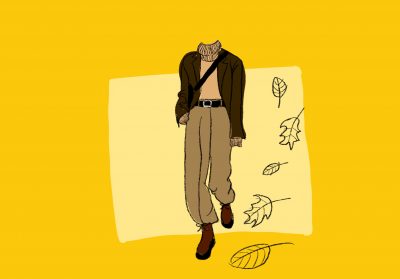The first autumn showers have started to kick in, and while it means the end of my heat-styled hair completing a successful stint down rainy Commonwealth Avenue, I can’t help but be excited for what it entails: fall fashion. Starting from the pumpkin spice latte and infinity scarf era, fall has always meant more layers, more accessories and more style all around.
But after 2019’s endless rollout of ‘Christian Girl Autumn’ Twitter memes placing an effective ‘thou-shalt-not’ on basic fall trends, not to mention the recent transition to college in person, a new subculture has taken over fall fashion: Dark Academia.

Dark Academia has its roots in the preppier style we all recognize as pleated skirts and cardigans but draws on gothic influence for a darker, more antique look. Think Harry Potter meets Greek culture and arts with a hint of thrifting as a personality trait. The result is vaguely reminiscent of playing dress-up with your grandpa’s old clothes while also carrying an iced coffee and a MacBook. Dark Academia represents everything glamorous and distinguished about higher education.
Its harmony with college and studying is part of the reason why I love Dark Academia. What better aesthetic than a tweed-filled, book-promoting one to motivate you to study for midterms looming on the horizon? And despite its reliance on leather and heavier fabrics, Dark Academia practically has a copyright on layering, meaning dressing the part is pretty comfy.
These endless layers of satchels on houndstooth on cashmere all seek to do one thing: recreate the aesthetics of 19th century private English boarding schools and New England Ivies. Dark Academia has repackaged these beacons of elitism and male privilege into something that can be saved alongside a picture of Draco Malfoy on a Pinterest board. And while I’m happy the aesthetic’s popularity has made suiting the power and classiness of higher education much more accessible, romanticizing the bourgeois origins of universities shouldn’t make us forget that its separatist legacy lives on.
Think the extent of exclusionary male organizations are the fraternities whose parties you’ve given up trying to get your male friends into? At Harvard, final clubs — which are exclusive social clubs based on a variety of hobbies or traditions — continue 18th-century legacies with quiet traditions oozing with privilege and socially selective memberships. After all, most of the members come from the same New England prep schools and old money surnames.
Similar hallmarks of college’s elitist past endure at schools like Oxford, where drinking societies show that certain demographics will literally gate-keep consuming alcohol to prevent socializing outside of their tax bracket, and Yale, whose Skull and Bones Society had a flashy cameo on the ultimate example of glorifying academic elitism, the show “Gossip Girl.”
Perhaps the most disgusting manifestation of this legacy happened just this month when a club of white supremacists at the University of Amherst sent out a racist email to Black organizations on campus maligning them and their presence. The letter seemed to suggest college only belongs to a certain group of people, and the University’s delayed response certainly didn’t help dispel this sentiment.
Unfortunately, these harmful ideas about who deserves higher education have deep roots — starting from the very days of Dark Academia’s inspiration when only white men could access education and continuing into the secretive societies we have today which are relics of that same origin.
Pitted against the still present implications of that time, Dark Academia and the era it romanticizes becomes less innocent than a simple photoshoot centered around strategically placed spectacles and the pretense of reading.
Despite the rose-tinted filter the subculture puts on lasting legacies of harmful elitism, it has also expanded access to this selective world. Now, an outfit a 19th-century old-money Yale student would have worn is accessible to anyone willing to save a few pins and visit the vintage store.
Beyond just the clothes, every person wearing their tailored tweed outfit also feels the sense of intelligence, focus and professionalism the dressing style imports. I would venture that slipping on a tailored button-up and sitting in the library because Aesthetics Wiki told you “studying and reading” are “activities” of Dark Academia could be the impetus for a powerful academic pursuit or useful social connection.
And because the aesthetic is so accessible, those entering an intellectual frame through this style have many different identities. On college campuses, many of which are still homogenous and overwhelmingly white, these heterogeneous identities are desperately needed.
I’ve always believed fashion has the power to change your reality. In the case of Dark Academia, diverse bodies claiming an aesthetic associated with power and privilege, and leaning into their intelligence through their clothing, could be the first step to democratizing the environment that created Dark Academia in the first place.






















































































































Lola • Oct 8, 2021 at 10:49 am
Great article! This was very interesting to read